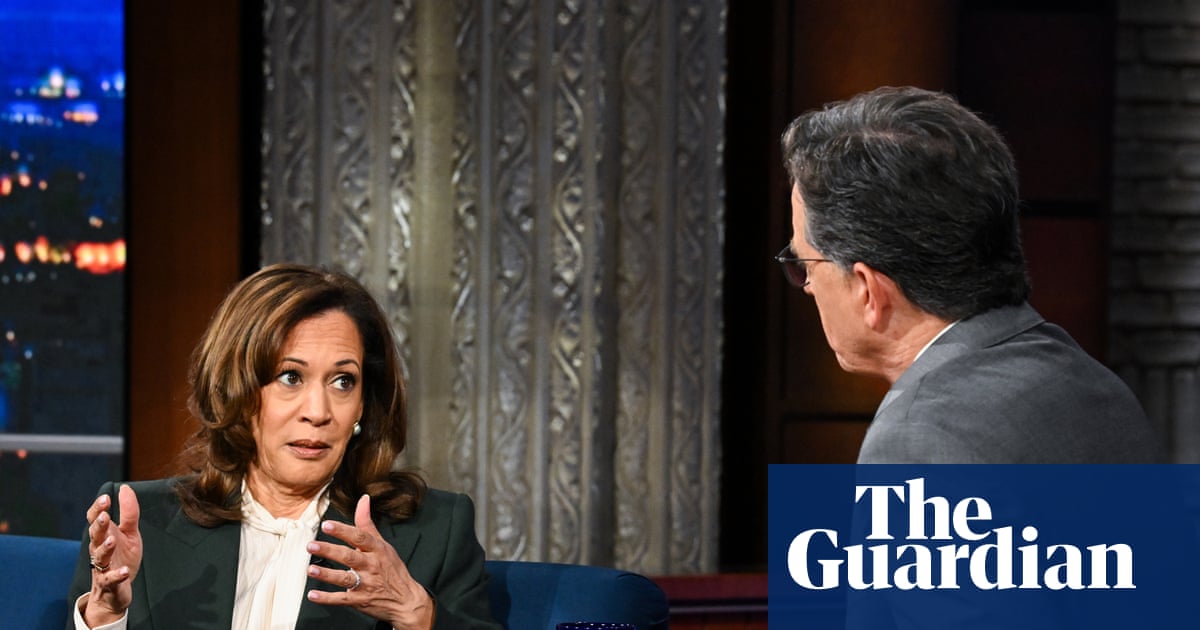The danger posed to Donald Trump was obvious. It was a story that not only drew attention to his links to a convicted sex offender, it also risked widening a growing wedge between the president and some of his most vociferous supporters. The White House quickly concluded a full-force response was required.
It was Tuesday 15 July. The Wall Street Journal had approached Trump’s team, stating it planned to publish allegations that Trump had composed a crude poem and doodle as part of a collection compiled for Jeffrey Epstein’s 50th birthday.
The claim would have been damaging at any moment, but the timing was terrible for the president. The Epstein issue was developing into the biggest crisis of his presidency. Strident Maga supporters had been angered by the Trump administration’s refusal to release government files relating to the late sex offender.
Trump and his loyal press secretary, Karoline Leavitt, reached for the nuclear option. From Air Force One, they called the Journal’s British editor-in-chief, Emma Tucker.

They turned up the heat. Trump fumed that the letter was fake. Drawing wasn’t his thing. Threats were made to sue, a course of action he had previously unleashed against other perceived media enemies.
Washington DC began to hum with rumours that the Journal had a hot story on its hands. When no article materialised on Wednesday, some insiders perceived a growing confidence within the White House that their rearguard action had killed the story. They were wrong.
DC’s gossip mill had reached fever pitch by Thursday afternoon. The article finally emerged in the early evening. The city collectively stopped to read.
In the hours that followed publication, the tension intensified. Trump revealed he had confronted Tucker, stating the story was “false, malicious, and defamatory”. By Friday, he had filed a lawsuit suing the Journal and its owners for at least $10bn (£7.6bn).
Tucker was at the centre of a maelstrom of stress and political pressure. It was the greatest challenge of her two and a half years heading the Journal, but far from the first.
Two months in, having been parachuted in from London, she was fronting a campaign to have the reporter Evan Gershkovich returned from a Russian prison. She had also faced denunciations from journalists as she pushed through a modernisation drive that included brutal layoffs. Her plans focused on giving stories a sharper edge. On that metric, the Trump call suggested she was overachieving.
Throughout her rise, an enigmatic quality has surrounded Tucker. Friends, colleagues and even some critical employees describe an amiable, fun and disarmingly grounded person. Many regarded her ability to retain such qualities in the treacherous terrain of the Murdoch empire as uncanny. The puzzle is exacerbated by the assumption she does not share the rightwing, pro-Brexit views of Rupert Murdoch, News Corp’s legendary mogul.
Yet Murdoch doesn’t hand the Journal to just anyone. While the pro-Maga Fox News is his empire’s cash cow, the Journal is his prized possession, giving him power and respectability in wider US political circles, as the Times does in the UK. So, why Tucker?
The answer, according to people who have worked with her, is her possession of two qualities Murdoch rates highly: a willingness to make unpopular decisions for the sake of his businesses and a lust for a politically contentious scoop.

Lionel Barber, a former Financial Times editor who also worked with Tucker for the FT in Brussels, said: “She has a very sharp nose for a good news story – always did.”
Tucker edited the University of Oxford’s student magazine, the Isis, and joined the FT as a graduate trainee. “She was a very convivial colleague, great company and good on a night out, but you knew when it came down to the work, she would nail it,” said a colleague. “Very hard-nosed.”
After stints in Brussels and Berlin, she won a powerful ally in Robert Thomson, then the FT’s foreign editor. Thomson became a close friend to Murdoch, a fellow Australian, while working in the US for the FT. Thomson jumped ship to edit the Times of London in 2002 and in 2008 was dispatched to New York to oversee Murdoch’s freshly acquired Journal. Before he went, Thomson helped lure Tucker to the Times, where she eventually became deputy editor.
It was her elevation to editor of the Sunday Times in 2020 that seems to have impressed Murdoch. She showed a willingness to make difficult staffing decisions and widened the Sunday Times’s digital ambitions, recasting the pro-Brexit paper to appeal to a wider audience.
It was there she made an enemy of her first populist world leader. Just months into her tenure, the Sunday Times published a damning account of how Boris Johnson, the then UK prime minister, had handled the Covid pandemic.
Downing Street erupted, taking the unusual step of issuing a lengthy rebuttal, denouncing “falsehoods and errors”. The paper was called “the most hostile paper in the country” to Johnson’s government, despite having backed him at the previous year’s election. Rachel Johnson, the former prime minister’s sister, is one of Tucker’s closest friends.

“I don’t think she was ever reckless,” said one Sunday Times staffer. “But I think she absolutely wanted to push the boundaries of getting as much into the public domain as she possibly could.”
Many assumed Tucker’s destiny was to edit the Times, but she was catapulted to New York to run the Journal at the start of 2023, immediately embarking on a painful streamlining process.
Senior editors were axed. Pulitzer prize winners ditched. The DC bureau, the most powerful, was particularly targeted with layoffs and new leadership.
One reporter spoke of people crying, another of the process’s serious mental impact. It made Tucker’s editorship divisive, leading to the extraordinary spectacle of journalists plastering her unoccupied office with sticky notes denouncing the layoffs.
Even some who accepted cuts questioned the methods. Several pointed to the use of “performance improvement plans”, with journalists claiming they had been handed unrealistic targets designed to push them out the door. One described it as “gratuitously cruel”.
A Journal spokesperson said: “Performance improvement plans are used to set clear objectives and create a development plan that gives an employee feedback and support to meet those objectives. They are being used exactly as designed.”
The Tucker enigma re-emerged at the Journal, as staff noted the same mix of personable demeanour, enthusiasm for stories and willingness to make cuts.

“She’s very emotionally intelligent – like, the 99th percentile,” said one. They said morale had improved more recently. New hires have followed.
A cultural shift on stories also arrived. What emerges is a Tucker Venn diagram. At its overlapping centre lie stories with two qualities: they cover legitimate areas of public importance and aim squarely at eye-catching topics with digital reach.
Tucker gave investigative reporters the examples of Elon Musk and China as two potential areas. Some complained the topics were “clickbaity”. However, one journalist who had had reservations conceded: “Musk turned out to be a pretty good topic.” Tucker’s use of metrics around web traffic and time spent reading a story irked some reporters.
Headlines were made more direct. Honorifics such as “Mr” and “Mrs” were ditched. There was a ban on stories having more than three bylines. “She loosened a lot of the strictures that we had,” said one staffer. “We’re encouraged to write more edgy stories.”
Positioning the Journal as a punchy rival to the liberal New York Times juggernaut may be a good business plan, but doing so while not falling foul of Murdoch’s politics remains a delicate balance.
“There’s a particular moment now where the Wall Street Journal has to prove its mettle as the pre-eminent business and financial markets media organisation,” said Paddy Harverson, a contemporary of Tucker’s at the FT, now a communications executive. “They’re up against Trump, yet they have an historically centre-right editorial view. She has guided the paper along that tightrope really well.”
Allies said Tucker laid a marker of intent in terms of punchy stories when she published an article on the alleged cognitive decline of Joe Biden. It was initially described as a “hit piece” by the Biden administration. Some see the Epstein story as the latest evidence of Tucker’s shift.
There are journalists, however, who blame Trump’s response for giving the story attention it simply didn’t warrant. Others disagree about the extent of Tucker’s changes, pointing to the Journal’s history of breaking contentious stories, including the hush money paid to Stormy Daniels. However, the net result of the Epstein letter saga has been to draw attention to Tucker’s attempted change in tone.
Trump’s lawsuit means the furore may only just be beginning. Many seasoned media figures assume Murdoch, who does not respond well to bullying, will not back down. However, neither billionaire will relish having to face depositions and disclosures. Any settlement from Murdoch could put pressure on Tucker, depending on its details.
Dow Jones, which publishes the Journal, has said it has “full confidence in the rigour and accuracy of our reporting, and will vigorously defend against any lawsuit”. The courts may yet reject Trump’s case.
“I don’t think [Murdoch] will just flop over,” said Barber. “The issue here is that Trump went around boasting that he killed the story … For an editor, that’s very difficult. But I’m pretty damn confident there’s no way [Tucker] would publish without having it properly sourced.”

 German (DE)
German (DE)  English (US)
English (US)  Spanish (ES)
Spanish (ES)  French (FR)
French (FR)  Hindi (IN)
Hindi (IN)  Italian (IT)
Italian (IT)  Russian (RU)
Russian (RU)  6 hours ago
6 hours ago
























Comments